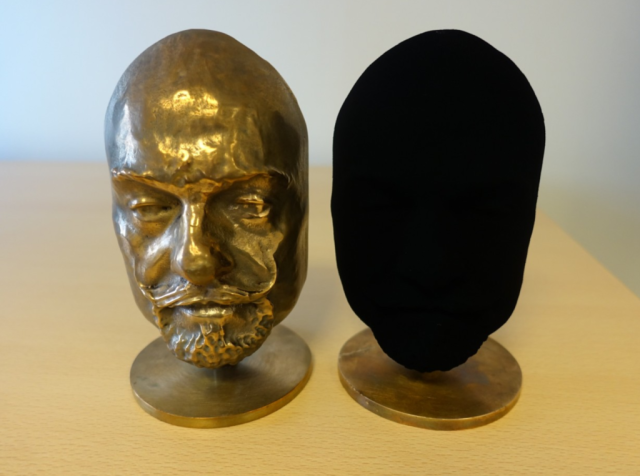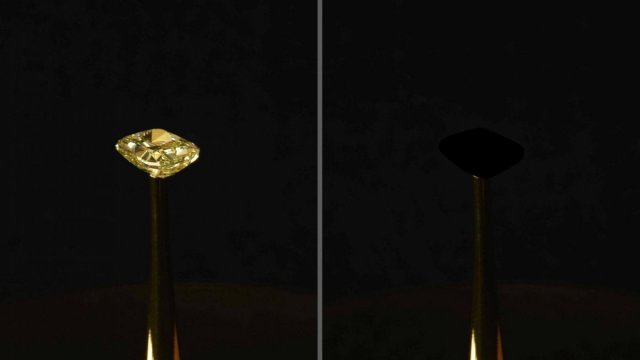Scientists Has Created The New Blackest Material Ever, Absorbing 99.96% Of Incoming Light
Viswamitra Jayavant - Sep 19, 2019

Scientists and artists from MIT have coated a $2 million diamond with the blackest material in the world, creating a unique art piece in the process.
- Bengaluru Engineers Have Created A New Plastic That's Strong Like Steel Yet Lightweight
- Origami-Inspired Metamaterial Can Help Reduce Crash Damage
- 'Metallic Wood' Is Our Next Innovative Material, Better Than Titanium
There’s always been a contest among material scientists to create the most ‘extreme’ of materials: The toughest metal, the most conductive alloy, the most fire-retardant fabrics, etc.

Now the scientists from the renowned Massachusetts Institute of Technology (MIT) is joining the race to create the darkest material in the world which, for a long time, has been crowned by Vantablack.
The team of scientists at MIT has done something more impressive. They have just coated a natural yellow diamond worth of $2 million on the market with a type of coating that, just like Vantablack, makes the gem looks like it’s a miniaturized black hole.
'The Redemption of Vanity'
The diamond has now become an art piece, fittingly called ‘The Redemption of Vanity.’ It is a collaborative effort between Diemut Strebe, an artist in residence at MIT Centre for Art, Science, and Technology who’s responsible mostly for the artistic aspect. For the technical and engineering aspect behind it, there’s Brian Wardle, a professor for aeronautics and astronautics at MIT.
If you want to see the unique art piece in all of its glory (Or lack thereof), you can drop by the New York Stock Exchange up where it'll be exhibited until November 25th.

Accidental Discovery
So what’s the magic trick behind the darkest diamond in the world?
In short, a type of carbon nanotube. In their official description of the project and the material, MIT likened it to “a fuzzy forest of tiny trees” made out of microscopic carbon filaments. These filaments are grown on top of a substrate made out of chlorine-etched Aluminium foil.
According to the report, the engineers created the material by accident when they were trying to figure out a new way to grow carbon nanotubes on top of electrically conducting substrates like Aluminium with the hope that it would create a new type of material with boosted electrical and thermal properties. The end result was not what they expected: A material that’s capable of absorbing 99.995% of incoming light, ten times more light absorbent than the previous record-holder Vantablack which can take in only 99.96%.
The team has fact-checked all of the data gathered from the new material and confirmed that it exceeded all previous records in ultra-black materials, including Vantablack. As of now, this unnamed material (And the diamond it was coated with) is the blackest on Earth.

Open License
These ultra-dark materials have aroused great interests in the optical and aerospace industries. But the MIT team responsible for the discovery is only extending the invitation out for artists and noncommercial projects for use.
The art community has also been enamored with these new materials. British sculptor Anish Kapoor is still holding the exclusive right to use Vantablack in his sculptures. Meanwhile, the rest of the art community is looking to Black 3.0 as the more accessible option for creative, ultra-black art projects. The material from MIT is just the new opportunity that artists can explore.
Wardle said that the material will not have a name, staying true to the core values of the Institute being the propagation of knowledge and opening it up for art and science projects.
Both of the ‘artists’ behind the impressive piece ‘The Redemption of Vanity’ had said that the material is open to everyone and that they will not license or give anyone exclusive rights to it as they believe in open application and utilization for all.
Featured Stories

Features - Jul 01, 2025
What Are The Fastest Passenger Vehicles Ever Created?

Features - Jun 25, 2025
Japan Hydrogen Breakthrough: Scientists Crack the Clean Energy Code with...

ICT News - Jun 25, 2025
AI Intimidation Tactics: CEOs Turn Flawed Technology Into Employee Fear Machine

Review - Jun 25, 2025
Windows 11 Problems: Is Microsoft's "Best" OS Actually Getting Worse?

Features - Jun 22, 2025
Telegram Founder Pavel Durov Plans to Split $14 Billion Fortune Among 106 Children

ICT News - Jun 22, 2025
Neuralink Telepathy Chip Enables Quadriplegic Rob Greiner to Control Games with...

Features - Jun 21, 2025
This Over $100 Bottle Has Nothing But Fresh Air Inside

Features - Jun 18, 2025
Best Mobile VPN Apps for Gaming 2025: Complete Guide

Features - Jun 18, 2025
A Math Formula Tells Us How Long Everything Will Live

Features - Jun 16, 2025
Comments
Sort by Newest | Popular